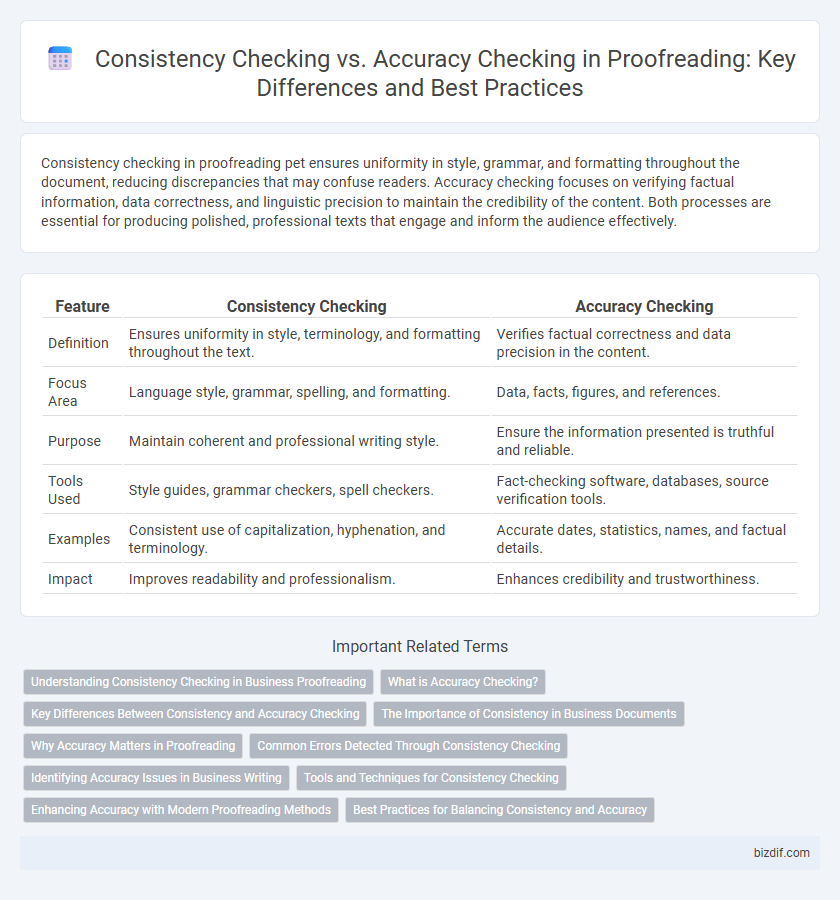Consistency checking in proofreading pet ensures uniformity in style, grammar, and formatting throughout the document, reducing discrepancies that may confuse readers. Accuracy checking focuses on verifying factual information, data correctness, and linguistic precision to maintain the credibility of the content. Both processes are essential for producing polished, professional texts that engage and inform the audience effectively.
Table of Comparison
| Feature | Consistency Checking | Accuracy Checking |
|---|---|---|
| Definition | Ensures uniformity in style, terminology, and formatting throughout the text. | Verifies factual correctness and data precision in the content. |
| Focus Area | Language style, grammar, spelling, and formatting. | Data, facts, figures, and references. |
| Purpose | Maintain coherent and professional writing style. | Ensure the information presented is truthful and reliable. |
| Tools Used | Style guides, grammar checkers, spell checkers. | Fact-checking software, databases, source verification tools. |
| Examples | Consistent use of capitalization, hyphenation, and terminology. | Accurate dates, statistics, names, and factual details. |
| Impact | Improves readability and professionalism. | Enhances credibility and trustworthiness. |
Understanding Consistency Checking in Business Proofreading
Consistency checking in business proofreading ensures uniformity in terminology, formatting, and style across all documents, reinforcing professional credibility and brand voice. It identifies discrepancies such as inconsistent use of acronyms, date formats, and product names that could confuse stakeholders or dilute messaging. Accuracy checking, by contrast, focuses on factual correctness and error-free content, but consistency checking provides a critical layer that maintains cohesion and reliability in corporate communications.
What is Accuracy Checking?
Accuracy checking in proofreading involves verifying that all facts, figures, names, and data within a text are correct and reliable, ensuring the information aligns with trusted sources. This process includes cross-referencing dates, numerical data, and quotations to prevent misinformation. Maintaining high accuracy is crucial for preserving the credibility and authority of any document.
Key Differences Between Consistency and Accuracy Checking
Consistency checking ensures uniformity in style, terminology, and formatting throughout a document, preventing discrepancies that could confuse readers. Accuracy checking focuses on verifying factual correctness, grammar, and punctuation to maintain the reliability and credibility of the content. Both processes are crucial in proofreading, but consistency checking targets alignment in presentation, while accuracy checking emphasizes error-free information.
The Importance of Consistency in Business Documents
Consistency in business documents ensures clarity and reinforces brand identity, which builds trust with clients and stakeholders. Uniform terminology, formatting, and style across reports, emails, and presentations prevent misunderstandings and enhance professionalism. Maintaining consistency reduces errors and streamlines communication, ultimately supporting efficient decision-making and operational success.
Why Accuracy Matters in Proofreading
Accuracy in proofreading ensures that the intended message is communicated clearly and professionally, reducing errors that could lead to misunderstandings or damage credibility. Unlike consistency checking, which focuses on uniform usage of style elements, accuracy checking targets correctness in grammar, spelling, and punctuation, directly impacting the text's reliability. Maintaining high accuracy in proofreading is crucial for producing polished, error-free documents that meet the standards of quality and professionalism.
Common Errors Detected Through Consistency Checking
Consistency checking in proofreading primarily targets errors such as inconsistent spelling, punctuation, and formatting throughout a document. Common errors detected include varied usage of hyphens, inconsistent capitalization of proper nouns, and discrepancies in date formats. Ensuring uniformity in these elements enhances the overall professionalism and readability of the text.
Identifying Accuracy Issues in Business Writing
Consistency checking ensures uniformity in terminology, formatting, and style throughout business documents, preventing misunderstandings. Accuracy checking focuses on verifying factual information, data correctness, and logical coherence to maintain credibility. Identifying accuracy issues requires careful cross-referencing of data, checking figures, and validating claims against reliable sources in business writing.
Tools and Techniques for Consistency Checking
Tools for consistency checking in proofreading primarily utilize algorithms that compare text segments to identify discrepancies in spelling, punctuation, and formatting across a document. Techniques include automated style guides and custom dictionaries integrated into software like Grammarly, PerfectIt, or Antidote, which highlight inconsistencies in terminology and grammar usage. These tools enhance efficiency by systematically scanning large texts, ensuring uniformity beyond simple accuracy checks that focus solely on correctness.
Enhancing Accuracy with Modern Proofreading Methods
Modern proofreading methods enhance accuracy by integrating consistency checking to ensure uniformity in spelling, punctuation, and style throughout the text. Advanced tools and software algorithms detect discrepancies and errors that traditional accuracy checking might overlook, such as inconsistent terminology or formatting variations. Combining both consistency and accuracy checks leads to higher-quality, error-free documents that meet professional standards.
Best Practices for Balancing Consistency and Accuracy
Consistency checking ensures uniformity in style, terminology, and formatting throughout the document, which enhances reader comprehension and professional appearance. Accuracy checking focuses on verifying factual correctness, grammatical precision, and syntactical integrity to maintain the document's credibility. Best practices involve integrating automated tools with manual review processes to balance consistency in language and formatting while ensuring factual accuracy without compromising one for the other.
consistency checking vs accuracy checking Infographic

 bizdif.com
bizdif.com